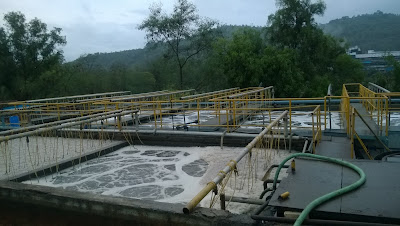 |
| Typical aeration tank in a wastewater treatment plant |
Introduction
Water scarcity and pollution are two of the most pressing global challenges today. While water sustains life, its misuse and contamination create serious risks for both humans and ecosystems. This is where wastewater treatment becomes crucial.
According to Metcalf & Eddy’s Wastewater Engineering: Treatment and Reuse, wastewater is not just “dirty water.” It is a complex mixture of contaminants that require scientific and systematic treatment before being released or reused. In this article, we will explore what wastewater is, its sources, and why treating wastewater is so important for a sustainable future.
What is Wastewater?
Wastewater refers to the water that has been used in households, industries, agriculture, or urban runoff and has become contaminated. It contains physical, chemical, and biological pollutants that make it unsafe for direct discharge.
Major Sources of Wastewater
-
Domestic Wastewater (Sewage):
From kitchens, bathrooms, toilets, and laundries. Contains organic matter, soaps, detergents, and pathogens. -
Industrial Wastewater:
Discharges from industries like textiles, food processing, pharmaceuticals, and chemicals. Often contains heavy metals, toxic substances, and oils. -
Stormwater Runoff:
Rainwater flowing over roads and urban areas picks up oil, grease, plastics, and sediments. -
Agricultural Wastewater:
Runoff from fields carries fertilizers, pesticides, and animal waste.
Composition of Wastewater
Wastewater typically contains:
-
Organic Matter (proteins, fats, carbohydrates)
-
Nutrients (nitrogen and phosphorus)
-
Suspended Solids (silt, grit, plastics)
-
Pathogens (bacteria, viruses, parasites)
-
Toxic Chemicals (pesticides, solvents, pharmaceuticals, heavy metals)
Importance of Wastewater Treatment
Treating wastewater is essential for multiple reasons:
1. Environmental Protection
Untreated wastewater pollutes rivers, lakes, and oceans. Organic matter depletes oxygen, killing fish and aquatic organisms. Excess nutrients cause eutrophication and algal blooms, destroying ecosystems.
2. Safeguarding Public Health
Pathogens in wastewater spread diseases like cholera, typhoid, dysentery, and hepatitis. Wastewater treatment eliminates harmful microorganisms and ensures safe water discharge.
3. Water Reuse
In water-scarce regions, treated wastewater becomes a valuable resource. It can be reused for:
-
Agricultural irrigation
-
Industrial cooling and processes
-
Construction activities
-
Potable reuse (with advanced treatment)
4. Legal Compliance
Regulations require industries and municipalities to meet specific discharge standards. Effluent Treatment Plants (ETP) and Sewage Treatment Plants (STP) are necessary to avoid fines and legal issues.
5. Resource Recovery
Modern wastewater treatment focuses on resource recovery, including:
-
Biogas from sludge (renewable energy)
-
Safe water reuse
Stages of Wastewater Treatment
Based on Metcalf & Eddy, wastewater treatment typically involves:
-
Preliminary Treatment: Screening and grit removal.
-
Primary Treatment: Settling of suspended solids.
-
Secondary Treatment: Biological treatment using microorganisms (activated sludge, trickling filters, etc.).
-
Tertiary Treatment: Advanced treatment for nutrient removal and polishing.
-
Disinfection: Chlorination, UV, or ozone to kill pathogens.
Global Significance of Wastewater Management
Globally, more than 80% of wastewater is released untreated into the environment. This practice threatens ecosystems, drinking water supplies, and public health. Countries facing water scarcity—such as India, South Africa, and the Middle East—are turning to wastewater reuse as a sustainable solution.
Wastewater should not be viewed as a liability but as a resource. Proper treatment and reuse can reduce water stress, protect rivers, and support economic growth.
Conclusion
Wastewater is more than just “used water.” It is a mixture of contaminants that, if untreated, can harm people and the planet. At the same time, it is also an opportunity for resource recovery and sustainable water management.
As Metcalf & Eddy’s Wastewater Engineering highlights, wastewater treatment is not only about compliance but also about protecting public health, conserving natural resources, and ensuring water security for the future.
The choice is ours: do we treat wastewater as a burden, or do we embrace it as a valuable resource?



